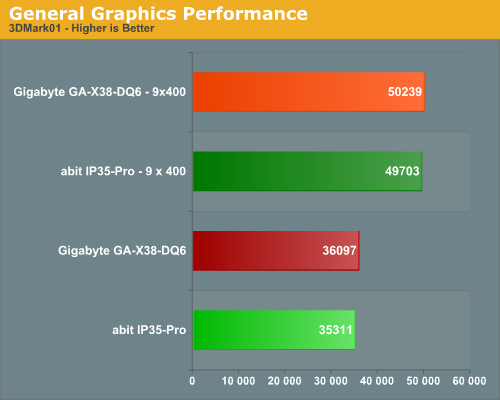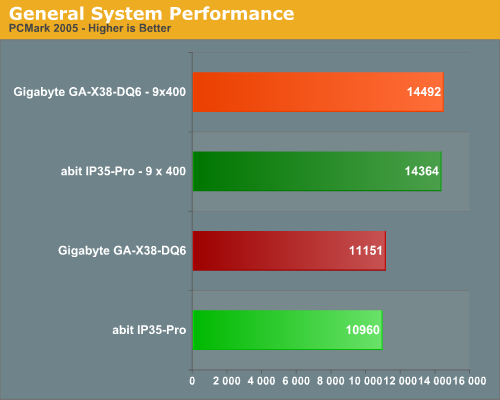Gigabyte GA-X38-DQ6: An early look at X38
by Gary Key on September 4, 2007 3:00 AM EST- Posted in
- Motherboards
Synthetic Graphics Performance
The 3DMark series of benchmarks developed and provided by Futuremark are among the most widely used tools for benchmark reporting and comparisons. Although the benchmarks are very useful for providing apple to apple comparisons across a broad array of GPU and CPU configurations they are not a substitute for actual application and gaming benchmarks. In this sense we consider the 3DMark benchmarks to be purely synthetic in nature but still valuable for providing consistent measurements of performance.


In our 3DMark06 test, the X38 and P35 are basically even in this test. The Gigabyte board is around 2% faster when overclocked although this margin is still relatively small. When looking at the individual tests, the Gigabyte board scored slightly better in the SM2.0 and SM3.0 tests while the CPU scores were just about identical when comparing the two chipsets.
In the more memory and CPU throughput sensitive 3DMark01 benchmark we see our Gigabyte GA-X38-DQ6 board about 2% quicker at stock speeds and only 1% when overclocked. The differences in performance are not really noticeable in either 3DMark unless you're looking to reach the top of the ORB, which we have a good feeling the X38 was designed to do with the right setup.
General System Performance
The PCMark05 benchmark developed and provided by Futuremark is designed to measure overall system performance for the typical home computing user. This tool provides both system and component level benchmarking results utilizing subsets of real world applications or programs. This benchmark is useful for providing comparative results across a broad array of Graphics, CPU, Hard Disk, and Memory configurations along with multithreading results. In this sense we consider the PCMark benchmark to be both synthetic and real world in nature and it again provides consistency in our benchmark results.

Our PCMark05 scores mimic the results from our 3DMark benchmarks with differences of around 2% at stock speeds and 1% when overclocked. While this benchmark is designed around actual application usage, we will see if these results mirror our own real-world application testing.
The 3DMark series of benchmarks developed and provided by Futuremark are among the most widely used tools for benchmark reporting and comparisons. Although the benchmarks are very useful for providing apple to apple comparisons across a broad array of GPU and CPU configurations they are not a substitute for actual application and gaming benchmarks. In this sense we consider the 3DMark benchmarks to be purely synthetic in nature but still valuable for providing consistent measurements of performance.


In our 3DMark06 test, the X38 and P35 are basically even in this test. The Gigabyte board is around 2% faster when overclocked although this margin is still relatively small. When looking at the individual tests, the Gigabyte board scored slightly better in the SM2.0 and SM3.0 tests while the CPU scores were just about identical when comparing the two chipsets.
In the more memory and CPU throughput sensitive 3DMark01 benchmark we see our Gigabyte GA-X38-DQ6 board about 2% quicker at stock speeds and only 1% when overclocked. The differences in performance are not really noticeable in either 3DMark unless you're looking to reach the top of the ORB, which we have a good feeling the X38 was designed to do with the right setup.
General System Performance
The PCMark05 benchmark developed and provided by Futuremark is designed to measure overall system performance for the typical home computing user. This tool provides both system and component level benchmarking results utilizing subsets of real world applications or programs. This benchmark is useful for providing comparative results across a broad array of Graphics, CPU, Hard Disk, and Memory configurations along with multithreading results. In this sense we consider the PCMark benchmark to be both synthetic and real world in nature and it again provides consistency in our benchmark results.

Our PCMark05 scores mimic the results from our 3DMark benchmarks with differences of around 2% at stock speeds and 1% when overclocked. While this benchmark is designed around actual application usage, we will see if these results mirror our own real-world application testing.










26 Comments
View All Comments
BLHealthy4life - Thursday, September 13, 2007 - link
According to the INQ, this mobo will be available on the 14th, tommorrow.I've only found retailers for this board in the UK.
Anyone been able to find a USA retailer(s) that have this board for preorder?
Thanks
TokyoFerret - Tuesday, January 22, 2008 - link
Are such powerful PSUs utilised in overclocking articles? I am thinking of buying this board and running it with an E6850, 4Gb RAM and a 8800GTX, 2 SATA drives and 3D Galaxy2 water cooling but my PSU is only rated at 500W (Enermax Liberty).Should I be buying a new PSU as well? Or try out my current one and upgrade if its voltage seems too unstable...
TokyoFerret - Tuesday, January 22, 2008 - link
Correction...Are such -> Why are such...
bigphil1974 - Tuesday, September 11, 2007 - link
Hi thanks for a great previewWould this motherboard pose any problems installing a large heatsink with backplate such as a thermalright ultra 120 extreme as I have seen similar gigabyte products where you cannot install bolt through coolers due to copper blocks on the back of the motherboard.
Thanks
Bigphil
larciel - Wednesday, September 5, 2007 - link
so not neglectible difference between P35 and X38, just like P965 and x975 weren't that much different.Upgrade bug is so addictive but I've learned to avoid it after spending $$$$$$$ just to satisfy my desire that dies the first day I get a new toy, or CPU, or motherboard in this case.
457R4LDR34DKN07 - Wednesday, September 5, 2007 - link
What I want to see is the ASUS ROG Maximus Formula SE.Lord Evermore - Tuesday, September 4, 2007 - link
Does having more PCIe lanes automatically mean higher power consumption? If they're unused, if you just have the same hardware installed, does power consumption go up significantly just because the lanes are available? I'd assume a small amount but not so much that you'd really notice it unless you actually were taking advantage of the increase.Dawgneck - Tuesday, September 4, 2007 - link
Gary, can you confirm if the X38 chipset will only support Crossfire, or will it also support SLI?JarredWalton - Tuesday, September 4, 2007 - link
This is an NVIDIA issue. NVIDIA needs to allow it in their drivers, or the only way to make it work will be hacking drivers. There have been various custom driver releases in the past to get SLI working on certain chipsets - i.e. the Alienware m9750 laptop and other SLI laptops are 945GM chipsets but still support SLI. The real issue here is whether or not Intel will pay NVIDIA... and how much NVIDIA wants to be paid, I would assume.Gary and I have had conversations about this, and while the NVIDIA GPU guys would love to get Intel chipset SLI support, the NVIDIA chipset guys are understandably not as gung-ho. Personally, I'd say their chipset business on the high-end doesn't do enough to compensate for the number of 8800 cards they could sell if they were to license SLI support to Intel. Besides, profit margins on 8800 chips (and even 8600) are *much* higher than chipset profit margins. For every 8800 card they sell, they probably make as much as they would off of four SLI chipset sales.
Will we ever see SLI support on Intel chipsets? That's going to depend on the two companies and pretty much nothing else. It could work right now... heck, it could work on 975X, P965, P35, and pretty much any dual-x16 slot motherboard+chipset.
PeteRoy - Tuesday, September 4, 2007 - link
Anandtech is a great site to show Battlefield 2 benchmarks, this is the game I play the most and I find it odd that sites like THG and others tend to ignore this game and show benchmarks of doom3 which nobody plays anymore, and if they do they won't after they finish the single player.